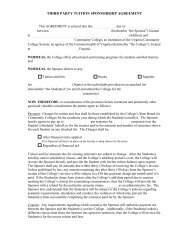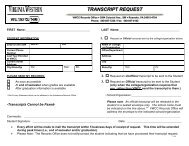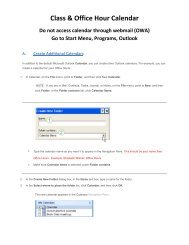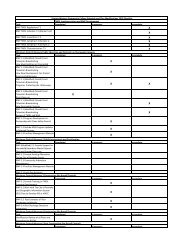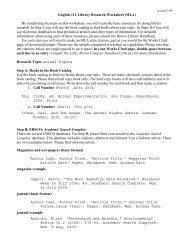Hazard Communication Program Information - Virginia Western ...
Hazard Communication Program Information - Virginia Western ...
Hazard Communication Program Information - Virginia Western ...
You also want an ePaper? Increase the reach of your titles
YUMPU automatically turns print PDFs into web optimized ePapers that Google loves.
<strong>Hazard</strong> <strong>Communication</strong> <strong>Program</strong><br />
INTRODUCTION<br />
The OSHA <strong>Hazard</strong> <strong>Communication</strong> Standard was promulgated to ensure that all chemicals would be<br />
evaluated and that information regarding the hazards would be communicated to employers and<br />
employees. The goal of the standard is to reduce the number of chemically related occupational<br />
illnesses and injuries.<br />
In order to comply with the <strong>Hazard</strong> <strong>Communication</strong> Standard, this written program has been<br />
established for <strong>Virginia</strong> <strong>Western</strong> Community College (VWCC). All divisions and sections of the College<br />
are included within this program. Copies of this written program will be available in the following<br />
location for review by any employee:<br />
<strong>Virginia</strong> <strong>Western</strong> Community College<br />
Human Resources Department<br />
3093 Colonial Avenue<br />
Fishburn Hall – Ground Floor<br />
Roanoke, VA 24015<br />
The basic components of this program include:<br />
<strong>Hazard</strong> <strong>Communication</strong> Coordinators<br />
Material Safety Data Sheets<br />
<strong>Hazard</strong>ous Chemical Inventory List<br />
<strong>Hazard</strong> Determination<br />
Disposal of <strong>Hazard</strong>ous Chemicals<br />
Labels and Other Forms of Warning<br />
Employee <strong>Information</strong> and Training<br />
Non-Routine Tasks<br />
Unlabeled Pipes<br />
Multi-Employer Workplaces<br />
<strong>Hazard</strong>ous Materials Incident<br />
<strong>Program</strong> Review<br />
<strong>Hazard</strong> <strong>Communication</strong> Training Form<br />
HAZARD COMMUNICATION COORDINATORS<br />
The following VWCC personnel have been designated as <strong>Hazard</strong> <strong>Communication</strong> Coordinators. These<br />
employees will be responsible for maintaining the <strong>Hazard</strong> <strong>Communication</strong> <strong>Program</strong> requirements listed<br />
hereafter for areas under their assigned responsibility. This responsibility will be part of the individual’s<br />
position description and performance plan and evaluation. Coordinators will periodically report their<br />
maintenance of and compliance with this program to the Human Resources Office.<br />
Department Head, Horticulture – F0066<br />
Trades Technician IV - FMS – 00132<br />
Director, Facilities Management Services – FA051<br />
Division Dean, Humanities – Photography Lab and<br />
Art - FA102<br />
Instructor – Culinary Arts – F0006<br />
Printing Technician III - 00047<br />
Trainer and Instructor I - Chemistry - 00036<br />
Trainer and Instructor I – Biology - 00075<br />
Trainer and Instructor I – HVAC, Welding and<br />
Electrical – 00086<br />
Training and Instructor II – Greenfield – 00023<br />
Trainer and Instructor III – Dental - 00095<br />
MATERIAL SAFETY DATA SHEETS (MSDS)<br />
When chemicals are ordered, the <strong>Hazard</strong> <strong>Communication</strong> Coordinator shall specify on the purchase<br />
order that chemicals are not to be shipped without corresponding Material Safety Data Sheets (MSDS).<br />
1
<strong>Hazard</strong> <strong>Communication</strong> <strong>Program</strong><br />
When MSDSs arrive with the corresponding chemical, the sheets will be reviewed for completeness by<br />
the respective <strong>Hazard</strong> <strong>Communication</strong> Coordinator. Should any MSDS be incomplete, a letter will be<br />
sent immediately to the manufacturer requesting the additional information.<br />
A complete file of MSDSs for all hazardous chemicals to which employees of this agency may be<br />
exposed to will be kept in labeled binders in an area that is readily accessible to employees within each<br />
<strong>Hazard</strong> <strong>Communication</strong> Coordinator’s area of assigned responsibility.<br />
MSDS will be available for employees during each work shift. Should MSDSs be unavailable, please<br />
contact the <strong>Hazard</strong> <strong>Communication</strong> Coordinator for the respective area immediately.<br />
MSDSs will be reviewed annually by the respective <strong>Hazard</strong> <strong>Communication</strong> Coordinator. Should there<br />
be any MSDS that has not been updated within the past year; a new MSDS will be requested.<br />
HAZARDOUS CHEMICAL INVENTORY LIST<br />
A list of hazardous chemicals (also known as the “<strong>Hazard</strong>ous Chemical Inventory List”) used by each<br />
department will be filed at the front of the Material Safety Data Sheet file binders in the respective<br />
department and will serve as an index to the Material Safety Data Sheets that follow. The <strong>Hazard</strong>ous<br />
Chemical Inventory List will be updated as needed to accurately reflect additions or deletions of<br />
hazardous chemicals present in the workplace.<br />
HAZARD DETERMINATION<br />
All hazardous chemicals in this facility are purchased materials; there are no manufactured or<br />
intermediate hazardous chemicals. Therefore, VWCC shall rely on the hazard determination made by<br />
the chemical manufacturer as indicated on the MSDS.<br />
DISPOSAL OF HAZARDOUS CHEMICALS<br />
Each department at the College is responsible for ensuring that hazardous chemicals generated within<br />
their area are safely stored and disposed of in a timely manner. Departments should dispose of<br />
chemicals that are spent, out-of-date, discontinued from use in the program, etc., at least annually but<br />
more frequently if necessary to avoid instability or storage problems.<br />
LABELS AND OTHER FORMS OF WARNING<br />
The <strong>Hazard</strong> <strong>Communication</strong> Standard requires that hazardous chemicals be labeled by manufacturers.<br />
Labels on incoming containers of hazardous chemicals are not to be removed or defaced. Please<br />
ensure the label contains the following information:<br />
Identity of the hazardous chemical<br />
Appropriate hazard warnings<br />
Name & address of chemical manufacturer, importer, or other responsible party<br />
2
<strong>Hazard</strong> <strong>Communication</strong> <strong>Program</strong><br />
When chemicals are ordered by the <strong>Hazard</strong> <strong>Communication</strong> Coordinator, the purchase order will<br />
indicate the need for the above stated information to be included on the labels, or VWCC will refuse<br />
acceptance of the shipment.<br />
Upon delivery of chemicals, the <strong>Hazard</strong> <strong>Communication</strong> Coordinator will ensure that chemicals are<br />
labeled properly. Any chemicals without proper labeling will not be accepted.<br />
When chemicals are transferred from the manufacturer's containers to secondary containers, the<br />
<strong>Hazard</strong> <strong>Communication</strong> Coordinator of each section will ensure that the containers are labeled with the<br />
identity of the chemicals and appropriate hazard warnings.<br />
The entire labeling procedure will be reviewed annually by the <strong>Hazard</strong> <strong>Communication</strong> Coordinator and<br />
changed as necessary.<br />
EMPLOYEE INFORMATION AND TRAINING<br />
Prior to starting work, new employees of VWCC will attend a departmental health and safety orientation<br />
program. The respective <strong>Hazard</strong> <strong>Communication</strong> Coordinator and/or Supervisor is responsible for<br />
organizing and conducting the initial training.<br />
The following topics will be covered:<br />
An overview of the requirements of the <strong>Hazard</strong> <strong>Communication</strong> Standard<br />
The labeling system and how to use it<br />
How to review MSDSs and where they are kept<br />
Chemicals present in work operations<br />
Physical and health effects of hazardous chemicals<br />
Methods and observation techniques used to determine the presence or release of<br />
hazardous chemicals in the area<br />
Personal protective equipment and work practices to lessen or prevent exposure to<br />
chemicals<br />
Steps the company has taken to lessen or prevent exposure to chemicals<br />
Safety/emergency procedures to follow if exposure occurs<br />
Location and availability of the written hazard communication program.<br />
Following each training session, the employee is required to sign and date the training record verifying<br />
attendance. Training records will be kept in the same labeled binders as the Material Safety Data<br />
Sheets in each respective department.<br />
Before any new employee can begin work which requires the use of or potential exposure to hazardous<br />
chemicals, training as indicated above must be completed.<br />
Additional training will be provided with the introduction of each new hazard. Records of the additional<br />
training will be maintained.<br />
NON-ROUTINE TASKS<br />
Prior to an employee beginning a hazardous non-routine task, he/she must report to the <strong>Hazard</strong><br />
<strong>Communication</strong> Coordinator to determine the hazards involved and the protective equipment required.<br />
3
<strong>Hazard</strong> <strong>Communication</strong> <strong>Program</strong><br />
UNLABELED PIPES<br />
Work activities are often performed in areas where chemicals are transferred through pipes. These<br />
pipes are not required to be labeled; however, the employees need to be aware of potential hazards.<br />
Prior to starting work in areas having unlabeled pipes, the employee shall contact the <strong>Hazard</strong><br />
<strong>Communication</strong> Officer to determine:<br />
The identity of the chemical in the pipes<br />
Potential hazards<br />
Safety Precautions<br />
MULTI-EMPLOYER WORKPLACES<br />
Often one (1) or more contractors on site at VWCC or employees of VWCC work at a site with<br />
employees of other employers. When employees of other employers are exposed to chemicals used or<br />
stored by VWCC, and these other employers will be provided with:<br />
Copies of all relevant the MSDSs<br />
<strong>Information</strong> on any precautionary measures that need to be taken to protect employees<br />
The chemical labeling system used<br />
The <strong>Hazard</strong> <strong>Communication</strong> Coordinator is responsible for providing other employers with an MSDS or<br />
ensuring that the MSDS is available in the respective department.<br />
The <strong>Hazard</strong> <strong>Communication</strong> Coordinator is responsible for providing other employers with information<br />
on precautionary measures that need to be taken to protect employees. This information will be<br />
provided (verbally, in writing, or other methods).<br />
The <strong>Hazard</strong> <strong>Communication</strong> Coordinator is responsible for informing other employers of the labeling<br />
system used. This information will be provided (verbally, in writing, or other methods). If a number or<br />
pictograph system is used, then the legend explaining the numbers and pictograph should be given to<br />
the employees or posted in the work area.<br />
HAZARDOUS MATERIALS INCIDENT<br />
For information about hazardous material spills or releases, please refer to the “VWCC Crisis<br />
Management Plan”; section 14 “<strong>Hazard</strong>ous Materials Incidents”.<br />
PROGRAM REVIEW<br />
This written <strong>Hazard</strong> <strong>Communication</strong> <strong>Program</strong> for <strong>Virginia</strong> <strong>Western</strong> Community College will be reviewed<br />
by Human Resources annually and updated as necessary.<br />
Reviewed: June 2009<br />
####<br />
4
<strong>Hazard</strong> <strong>Communication</strong> <strong>Program</strong><br />
HAZARD COMMUNICATION EMPLOYEE TRAINING FORM<br />
This is to certify that I have been given training information as required by OSHA’s <strong>Hazard</strong><br />
<strong>Communication</strong> Standard, 29 CFR 1910.1200.<br />
1. An overview of the <strong>Hazard</strong> <strong>Communication</strong> Standard requirements.<br />
2. Chemicals present in the work place operations.<br />
3. Location and availability of the written <strong>Hazard</strong> <strong>Communication</strong> <strong>Program</strong>.<br />
4. How to obtain information regarding the physical and health effects of the hazardous chemicals<br />
in the work area.<br />
5. Methods and observation techniques used to determine the presence or release of hazardous<br />
chemicals in the work area.<br />
6. How to lessen or prevent exposure to the hazardous chemicals through usage of control/work<br />
practices and personal protective equipment.<br />
7. Safety emergency procedures to follow if exposed to hazardous chemicals in the work place.<br />
8. How to read labels and review MSDSs to obtain appropriate hazard information.<br />
9. I have been given an opportunity to ask questions about the <strong>Hazard</strong> <strong>Communication</strong> Standard<br />
and to have those questions answered.<br />
==============================================================================<br />
I have read and understood the above statements.<br />
_____________________________________________________<br />
Employee Name (printed)<br />
_______________________<br />
Date<br />
_____________________________________________________<br />
Employee’s Signature<br />
_______________________<br />
Department<br />
________________________________________ _________________________________________<br />
Training Conducted By<br />
Signature<br />
5




